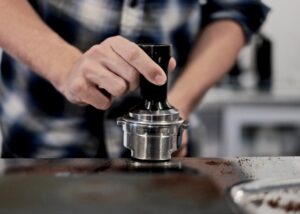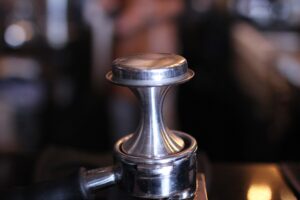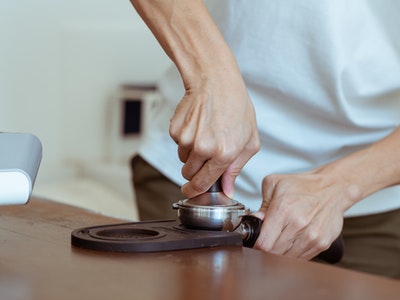Last Updated on 23/02/2022 by Miki
Table of contents
If you have a coffee grinder, you need to know how to tamp your coffee. If you don’t, don’t fret – I’ll show you how. Tamping is a vital skill for all coffee connoisseurs, and it can make a huge difference in how your coffee tastes. Once you learn the basics, you’ll be able to produce a cup that rivals that of any cafe.
Tamping your coffee might sound like the most mundane part of your coffee routine, but that simple step determines how strong your coffee is, which in turn affects the taste. While you might think that all you have to do is push down on the coffee grounds with a tamper, for a truly delicious cup of coffee, you need to do it just right. In this article, you’ll learn how to tamp your coffee properly 🙂

What Is Tamping Coffee?
A lot of people might not know what “tamping” is. Tamping is simply the act of compacting the coffee grounds by “tamping” them with the tamper. The act of tamping coffee grounds is the key to making a great cup of coffee. It’s all about creating that even consistency throughout the coffee grounds. A coffee tamper also allows the coffee to extract in a more efficient manner, giving the drinker a richer taste. The best way to use a coffee tamper is to tamp with medium pressure. This will yield a stronger coffee that still maintains a good taste. The weight, pressure, and speed of tamping all influence how well it works.
Why Is Tamping Coffee Important?
Coffee tamping is an important step because it has a major impact on the flavour and distribution of the coffee. When tamping, the barista is compressing the coffee grounds with a tool called a tamper. A high-grade stainless steel tamper is recommended. If the grounds are not compressed enough, the coffee shots will be weak and watery. If the grounds are compressed too hard, the coffee will be too dense and will produce a bitter, over-extracted taste. Tamping also uses a barista’s weight to apply pressure to the coffee particles, which increases extraction. The more a barista tamps, the more time it takes to extract the coffee. It is important for a barista to tamp coffee properly because it helps the coffee extract at a slower and more even pace, which leads to a perfect shot of espresso.
This post may contain affiliate links. If you use these links to purchase something, I may earn a commission without any extra cost to you. I would appreciate it if you do so to keep this blog going!
How To Tamp Coffee Properly
So, how do you tamp coffee properly? The key to making an excellent cup of coffee is in the grind of the coffee beans. If you don’t have the beans ground just right, the brewing time can be longer than necessary. This means that more acid is introduced to the coffee, leading to an over-extracted taste. A good way to make sure that your beans are ground just right is to invest in a quality coffee grinder. The following are five simple steps to tamp coffee properly.
- Use a digital scale to measure out the perfect amount of coffee grounds. You need to do this in grams, not in teaspoons or tablespoons.
- Grind your coffee beans to a medium-fine texture for better flavour extraction.
- Put the ground coffee into a filter, directly onto the machine’s grounds holder.
- Use a tamper to gently press the grounds. Start by pressing softly and continue pressing with increasing pressure until all of your grounds are evenly compressed.
- Make sure that coffee is packed thoroughly. The coffee should be level with the rim of the filter basket, but not packed so tightly that it overflows or so loose that it doesn’t contain enough coffee grounds to produce a full-bodied cup of coffee.
How Hard Should You Tamp?

Many people are not aware of how hard they are tamping their ground coffee. If tamped too hard, it will result in a dense, compact ground coffee. This means the water will not penetrate the ground coffee completely, leading to an under-extracted, acidic taste. If tamped too softly, it can lead to a weak, watery coffee. The goal is to find the perfect balance between too hard and too soft. A proper tamper should leave a nice round mound after it’s been tamped and should be dense enough to sink back down easily. If it doesn’t sink back down, you’re using too much pressure and need to be using less.
So how should you tamp? Well, if you need an actual guide, I would recommend tamping your coffee grounds down at a 45-degree angle at a rate of 30 pounds per square inch. How exactly do you measure the pressure? Well, the easiest way would be to use a click tamper. It’s designed to click when the desired pressure has been reached. This will be perfect for your tamping training. With a standard tamper, you may need to do some practice at the start, but you’ll get there eventually.
How To Tamp Coffee Without A Tamper
Coffee is a refreshing beverage that is enjoyed around the world. One step in making a cup of coffee is tamping the coffee grounds. Unfortunately, not everyone has a tamp, but luckily there are a number of techniques that can be used to tamp a coffee with or without a tamper. There are three things to consider when tamping without a tamper.
- First, pour your ground beans into your coffee maker’s filter basket.
- Try to give the basket a little shake so that the coffee grounds are more evenly distributed.
- Second, it is important to be careful not to put too much pressure on the coffee grounds.
- Third, using the palm of the hand is an effective technique for tamping.
Ultimately, the simplest way to tamp coffee without a tamper is by using a spoon. Gently press down on the coffee grounds, then move the spoon in a circular motion. Be sure to use a spoon that is sturdy and isn’t made out of metal. Another way is to use the palm of your hand to apply pressure to the coffee grounds to simulate a tamper. Or you can use any long and thin implement such as a rolling pin or the handle of a wooden spoon.
Final Thoughts
Despite coffee being a drink that a lot of people enjoy, few people know how to prepare coffee without a tamper. When you tamp the coffee, you are ensuring that the coffee will be ground evenly and consistently. With a tamper, it becomes easier to be sure that the coffee beans are level and that the water will be evenly distributed into the ground coffee beans.
As you have learned in this article, there are some alternative methods to tamp your coffee without a tamper like using a spoon. However, keep in mind that there is room for errors by using the tamper alternatives. For instance, an over-tamped shot can lead to a very thin cup of coffee. That’s why I highly recommend using a tamper to brew a delicious cup of coffee. It’s definitely worth investing in the good one for yourself.

How do I measure 30 pounds per square inch?
Thank you for pointing this out James. I have updated my post and I would recommend using a click tamper to measure the tamping pressure.